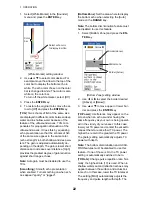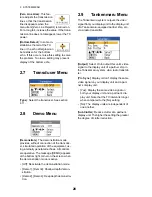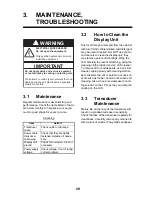
4. INSTALLATION
36
smooth as possible to provide an undis-
turbed flow of water around the transduc-
er. The fairing block should be smaller
than the transducer itself to provide a
channel to divert turbulent water around
the sides of the transducer rather than
over its face.
Construction of fairing block
3. Drill a hole just large enough to pass the
threaded stuffing tube of the transducer
through the hull, making sure it is drilled
vertically.
4. Apply a sufficient amount of high quality
caulking compound to the top surface of
the transducer, around the threads of the
stuffing tube and inside the mounting hole
(and fairing blocks if used) to ensure wa-
tertight mounting.
5. Mount the transducer and fairing blocks
and tighten the locknut. Be sure that the
transducer is properly oriented and its
working face is parallel to the waterline.
Typical thru-hull mount
transducer installations
Note:
Do not over-stress the stuffing tube and
locknut through excessive tightening, since
the wood block will swell when the boat is
placed in the water. It is suggested that the
nut be tightened lightly at installation and re-
tightened several days after the boat has
been launched.
Transducer preparation
Before putting the boat in water, wipe the face
of the transducer thoroughly with a detergent
liquid soap. This will lessen the time neces-
sary for the transducer to have good contact
with the water. Otherwise the time required for
complete "saturation" will be lengthened and
performance will be reduced.
DO NOT
paint the transducer. Performance
will be affected.
Hole for
stuffing tube
Saw along slope
of hull.
Upper Half
Lower Half
BOW
Flat Washer
Rubber Washer
Fairing
Block
Hull
Deep-V Hull
Hull
Flat Washer
Rubber
Washer
Cork
Washer
Flat Hull
Summary of Contents for FCV-627
Page 1: ...FISH FINDER FCV 627 OPERATOR S MANUAL www furuno com B R I L L GAIN ...
Page 62: ...D 1 ...
Page 63: ...D 2 ...






































